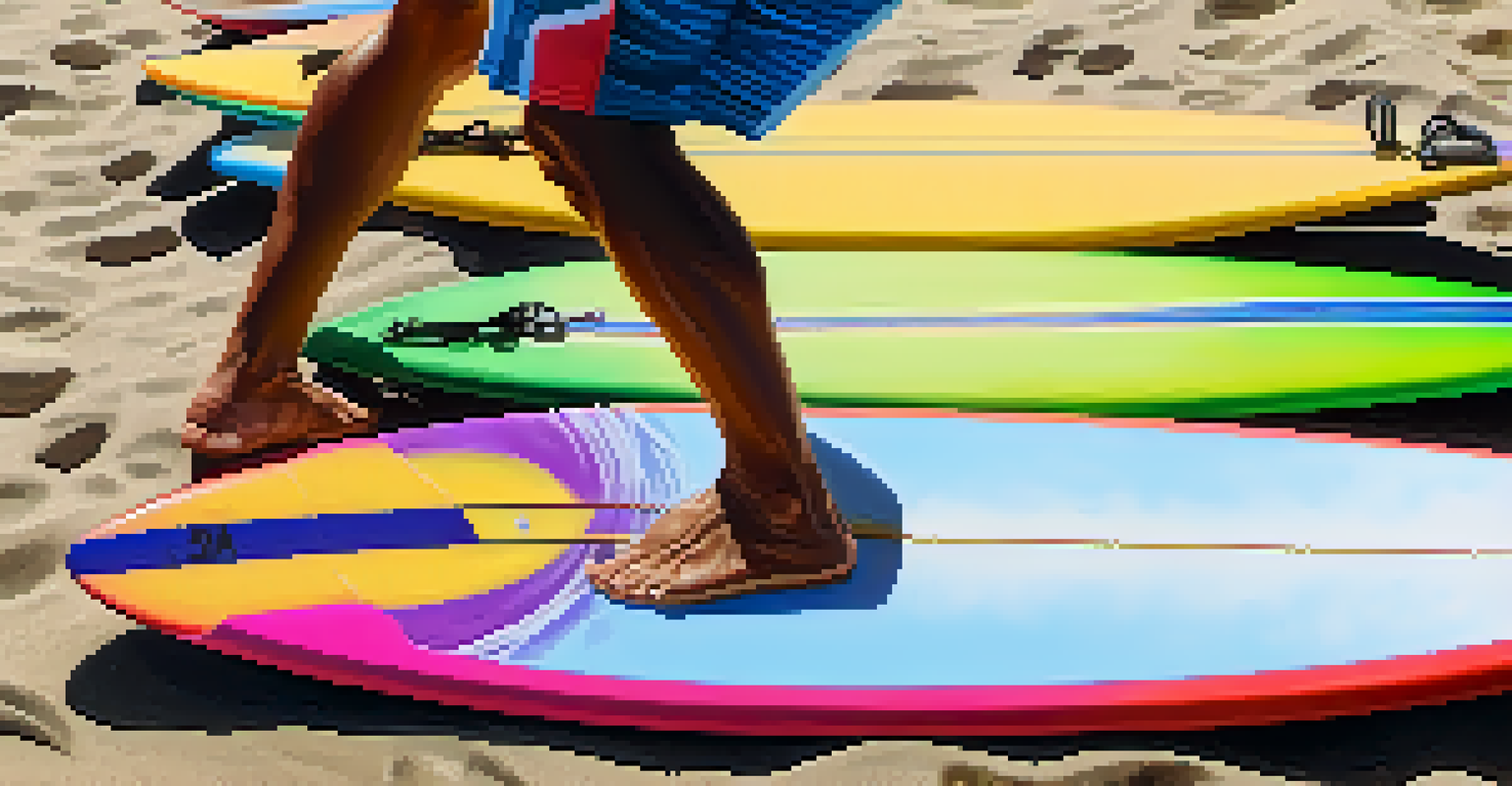Surfing Competitions: How They Work and Major Events

The Basics of Surfing Competitions Explained
Surfing competitions are structured events where surfers showcase their skills on waves, judged by a panel. Each competition typically has specific rules regarding wave selection, scoring, and duration. The aim is to demonstrate not only technical prowess but also creativity and style, making it as much an art form as a sport.
Surfing is not just a sport; it's a way of life, an expression of the soul, and a means of connecting with the ocean.
Competitions often vary in format, including single-elimination heats or more structured rounds, depending on the event size. Surfers compete against each other, riding the same waves to ensure a fair evaluation. This aspect makes it exciting for both participants and spectators, as the unpredictable nature of the ocean adds an element of surprise.
The scoring system is based on the best two waves that each surfer rides, with judges awarding points for difficulty, execution, and overall impression. This format encourages surfers to push their limits, resulting in breathtaking performances that captivate audiences.
Key Scoring Criteria in Surfing Competitions
Understanding how surfers are scored is crucial for appreciating competitions. Judges score each wave on a scale, considering factors such as the length of the ride, maneuvers performed, and the surfer's style. The better the execution, the higher the points, making every detail count.

One significant aspect is the difficulty of the maneuvers; more complex tricks earn higher scores. For instance, a surfer completing a flawless aerial maneuver on a challenging wave will score better than a simpler turn. This encourages surfers to innovate and refine their skills continuously.
Understanding Surfing Competitions
Surfing competitions involve surfers showcasing their skills on waves, judged on criteria like technical ability and creativity.
The judges' subjective nature can sometimes lead to debates about scoring, adding drama to the competition. Surfers and fans alike often discuss calls, creating a lively community that thrives on shared passion and differing opinions about what constitutes a perfect wave.
Major Surfing Competitions Around the Globe
Surfing boasts several prestigious competitions that attract top talent and massive audiences. Events like the World Surf League (WSL) Championship Tour highlight the sport's elite, showcasing the best surfers in iconic locations worldwide. Each of these events has its unique characteristics and challenges, contributing to the surfers' overall rankings.
The ocean stirs the heart, inspires the imagination, and brings eternal joy to the soul.
Another major event is the Vans Triple Crown of Surfing, which occurs annually in Hawaii, featuring three separate competitions. This series tests surfers' skills in various wave conditions, making it a crucial part of their competitive journey. The allure of Hawaii's waves draws both seasoned professionals and ambitious newcomers.
Additionally, the ISA World Surfing Games brings together surfers from different nations, fostering a spirit of camaraderie and competition. This event not only showcases individual talent but also promotes surfing as a global sport, encouraging national pride and unity among participants.
The Role of Technology in Surfing Competitions
In recent years, technology has transformed surfing competitions, enhancing both judging and viewing experiences. High-definition cameras capture every moment, allowing judges to review performances from multiple angles. This ensures fairness and accuracy in scoring, which is essential for maintaining the sport's credibility.
Moreover, live streaming has made competitions accessible to fans worldwide, bringing the excitement of the ocean directly into their homes. Viewers can experience the thrill of watching surfers ride massive waves, as if they were there on the beach. This increased accessibility has significantly expanded the sport's audience.
The Impact on Local Economies
These events boost local economies by attracting visitors and fostering community pride through shared surf culture.
Additionally, wearable technology is being experimented with, providing surfers with real-time data on their performance. This information can help them analyze their rides and improve their techniques, making the competition even more competitive as athletes strive for perfection.
How to Prepare for a Surfing Competition
Preparation is key for any surfer looking to compete, starting with physical training tailored to the demands of the sport. Surfers focus on building strength, endurance, and flexibility, often incorporating various workouts that enhance balance and core stability. This holistic approach equips them to handle the physical challenges they will face in the water.
Mental preparation is equally important; surfers often practice visualization techniques, imagining themselves successfully riding waves. This mental rehearsal builds confidence and reduces anxiety, allowing them to perform at their best on competition day. Positive self-talk and relaxation strategies also play a significant role in their preparation.
Finally, knowing the competition's location and conditions is crucial. Surfers study the waves, tides, and weather patterns leading up to the event, allowing them to develop strategies for success. This level of preparation can make a significant difference in their performance, helping them feel ready to tackle any challenge.
The Impact of Surfing Competitions on Local Communities
Surfing competitions often have a significant positive impact on local communities, drawing visitors and boosting the economy. These events attract not only surfers but also fans, sponsors, and media, all eager to experience the vibrant surf culture. Local businesses, from surf shops to restaurants, often benefit from increased foot traffic during competitions.
Moreover, these events can foster a sense of pride and identity within the community. Local surfers get the chance to compete alongside their heroes, inspiring young enthusiasts to pursue their dreams. This connection can spark interest in surfing, leading to growth in local surf schools and clubs.
Future Trends in Surfing Events
The future of surfing competitions is bright, with technological advancements and Olympic inclusion expanding its global appeal.
Additionally, many competitions prioritize environmental sustainability, promoting ocean conservation efforts. Organizers often partner with local organizations to clean beaches and raise awareness about protecting marine ecosystems. This commitment to the environment helps preserve the very waves that define the sport.
The Future of Surfing Competitions
As surfing continues to grow in popularity, the future of competitions looks bright, with new events and formats emerging. The inclusion of surfing in the Olympics has elevated the sport's profile, introducing it to a broader audience. This recognition may lead to increased investment and interest in competitive surfing globally.
Moreover, the evolution of technology will likely continue to shape how competitions are conducted and viewed. Innovations in judging systems and broadcasting will enhance the spectator experience, making competitions more engaging for fans. The potential for virtual competitions may also emerge, allowing surfers to compete remotely while still showcasing their skills.

Ultimately, the future of surfing competitions will be driven by the passion of surfers and the communities that support them. As long as there are waves to ride and surfers eager to challenge themselves, the competitive spirit of surfing will remain alive and thriving.